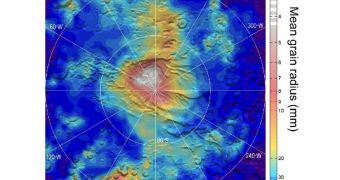Experts at the American space agency say that their Mars Reconnaissance Orbiter (MRO) was recently able to identify what could well be the first indicators of snow falling on the surface of another planet.
The spacecraft provides evidence that carbon dioxide snowfalls occur on Mars. If the discovery is confirmed, then this will be the first time precipitations of this type are found anywhere else in the solar system, except Earth.
Details of the new study were published in the latest issue of the esteemed Journal of Geophysical Research. The NASA team behind the study says that the dry ice – the one made up of carbon dioxide – needs temperatures of around –125 degrees Celsius (-193 degrees Fahrenheit) to form.
According to the group, these values again indicate just how much more different Mars is from Earth, even though the two planets share many similarities. The reality is rather harsh, since the Red Planet is not exactly what you would call a hospitable place.
MRO found the first evidence of CO2 snowfall while it was investigating clouds hovering over our neighboring world's south pole. Planetary scientists have known that dry ice exists at the Martian poles for decades, and the 2008 NASA Phoenix Mars Lander mission confirmed that.
“These are the first definitive detections of carbon-dioxide snow clouds. We firmly establish the clouds are composed of carbon dioxide – flakes of Martian air – and they are thick enough to result in snowfall accumulation at the surface,” Paul Hayne explains.
The expert, who holds an appointment with the NASA Jet Propulsion Laboratory (JPL), in Pasadena, California, was also the lead author of the JGR paper. Six other researchers co-authored the work.
Using data from MRO's Mars Climate Sounder (MCS) instrument, the team was able to analyze the CO2 clouds from both directly overhead and from side-angles. At the time of the study, Hayne was a postdoctoral research fellow at the California Institute of Technology, which manages JPL for NASA.
“One line of evidence for snow is that the carbon-dioxide ice particles in the clouds are large enough to fall to the ground during the lifespan of the clouds. Another comes from observations when the instrument is pointed toward the horizon, instead of down at the surface,” adds JPL expert, David Kass.
“The infrared spectra signature of the clouds viewed from this angle is clearly carbon-dioxide ice particles and they extend to the surface. By observing this way, the Mars Climate Sounder is able to distinguish the particles in the atmosphere from the dry ice on the surface,” he concludes.

 14 DAY TRIAL //
14 DAY TRIAL //